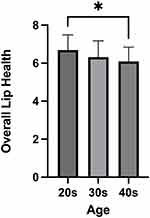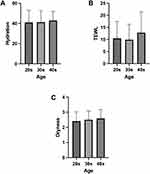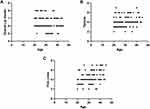Back to Journals » Clinical, Cosmetic and Investigational Dermatology » Volume 16
Clinical Features and Biophysical Characteristics of Lips of South Asian Women
Authors Subramanyam C , Gunt HB , Sivamani RK
Received 14 April 2023
Accepted for publication 19 July 2023
Published 26 July 2023 Volume 2023:16 Pages 1955—1961
DOI https://doi.org/10.2147/CCID.S417214
Checked for plagiarism Yes
Review by Single anonymous peer review
Peer reviewer comments 2
Editor who approved publication: Dr Jeffrey Weinberg
Chaitra Subramanyam,1,2 Hemali B Gunt,3 Raja K Sivamani1,4– 6
1Integrative Skin Science and Research, Sacramento, CA, USA; 2Western University of Health Sciences, Lebanon, OR, USA; 3Burt’s Bees, Durham, NC, USA; 4Pacific Skin Institute, Sacramento, CA, USA; 5Department of Dermatology, University of California-Davis, Sacramento, CA, USA; 6College of Medicine, California Northstate University, Elk Grove, CA, USA
Correspondence: Raja K Sivamani, Email [email protected]
Introduction: The vermillion lip has unique physical properties and environmental exposures make them prone to dryness and chapping. While lips contribute to facial beauty, perioral aging is highly individual and dependent on ethnicity. Specifically with regard to South Asian population, there is no other literature identified on the biophysical characteristics of the vermillion lip.
Methods: In this work, characteristics of the vermillion skin in South Asians were examined through various clinical and biophysical characteristics of the lips such as dryness and roughness, fine lip lines, lip texture, hydration, and barrier function. Healthy South Asian females, from age 20– 45 were recruited for this study and transepidermal water loss (TEWL), hydration, visual lip tolerance, and visual dryness were measured and graded by the dermatologist-investigator.
Results: Lip texture and fine lines significantly increased from the 20s to the 40s. Overall lip health significantly decreased with age. TEWL and dryness increased with age while hydration decreased with age, although not significantly so.
Discussion: This first-of-its kind study on South Asian females establishes that with age there is a decrease in overall lip health and an increase in signs of aging of the lips (fine lines, texture) from the 20s to 40s.
Keywords: aging, fine lines, lip, South Asian, texture
Introduction
The skin in the vermillion lip (colloquially known as lips) has unique properties from the skin on other parts of the body. It is oral mucosa that is continuously exposed to the outside environment. The barrier consists of a non-keratinized and thin epithelium,1,2 which allows the capillary loops to be easily seen under the skin and gives the lips a reddish color.3 As such, it more likely to have higher trans-epidermal water loss (TEWL) than skin on the cheeks.1
Due to the characteristics of the lips and its environmental exposure, lip skin is prone to dryness. The stratum corneum in lip skin is very thin, making lips less able to contain and retain hydration resulting in texture changes such as roughness.4 A study done by Tamura et al suggests that both the amount of ceramide and ceramide profiles in the stratum corneum of the lip skin contribute to lip roughness.4 Additionally, lip chapping may also be due to a decrease in cathepsin D activity and delayed movement of corneocytes through the stratum corneum.5
The lips are also critical in aesthetics and there are concerns that can arise with age. Problems due to shape and color become more apparent with age.6 Kim et al found that lips shorten in length and widen with age and this can make the lips appear thinner.6 Lip aesthetics can also vary by geography, ethnicity, and profession.7 These biophysical and aesthetic characteristics suggest that the skin of the vermillion lip requires special care to maintain the appearance, function, and overall health of the lips.
There are no studies to our knowledge on the biophysical characteristics of South Asian lips. Asia is a large and diverse continent, and most of the readily available literature on lips focuses on Caucasian populations.6,8 It is important to establish the basic foundational biophysical properties of South Asian lips and how these characteristics change with age. The objective of this study is to investigate and correlate characteristics of the vermillion skin in South Asian individuals by measuring dryness and roughness, fine lip lines, lip texture, hydration of lips, and barrier function.
Materials and Methods
This prospective, observational study was conducted according to the Declaration of Helsinki Principles. The protocol was approved by the ACEAS Independent Ethics Committee, and all study visits were conducted at a clinical site located in New Delhi, India. Written informed consent was obtained from each subject. 114 healthy female subjects from ages 20–45, Fitzpatrick skin types of IV–VI, with medium to full lips were enrolled in the study. As this was a pilot study, no power analysis was performed. Subjects who had changes to hormonal therapies or birth control in the past 3 months were excluded from the study. Patients who had undergone facial treatments in the past 4 months, including botulinum toxin and injectable fillers, were excluded from the study, however none of the enrolled subjects had undergone such treatment in the their lifetime. Subjects were asked to not apply any cosmetic products to the lips at least 48 hours before the visit. They were also asked to refrain from hot beverages, caffeine containing products, hot, spicy food, and smoking for at least 30 minutes before the evaluation.
The location for biophysical measurements was the center of the lower lip. A single measurement for transepidermal water loss (TEWL) was taken using the Tewameter TM300/MPA6 (Courage + Khazaka, Köln, Germany). Hydration was measured through a Corneometer CM 825/ MPA 6 (Courage + Khazaka, Köln, Germany) in triplicate. A visual assessment of lip tolerance was done by a dermatologist-investigator and measured on both objective (irritation, erythema, edema) and subjective (burning, stinging, itching, tightness, tingling, and others) scales. Visual grading for appearance of lip dryness, fine lines, texture, and overall health of lips was performed on a validated, photo numeric scale by the investigator as described below.
Lip dryness: Scale 0–8, 0 = No dryness or chapping evident, 1–2 = slight (definite roughness; fine scaling), 3–4 = Moderately roughness (coarse scaling; slight cracking), 5–6 = Marked roughness (coarse scaling; obvious cracking), 7–8 = Very marked roughness (coarse scaling; cracked progressing to fissuring).9
Lip fine lines: Scale 0–9, 0=absence of fine lip lines, 1-2- slight appearance of fine lip lines, 3-5- moderate prominence of fine lip lines, 6-7- marked prominence of fine lip lines, 8-9- extremely prominent lip lines.10
Lip texture: Scale 0–9, 0 =absence of lip roughness with a complete smooth texture, 1-2- slight roughness of lip texture, 3-5- moderate roughness of lip texture, 6-7- marked roughness of lip texture, 8-9- extremely rough lip texture.11
Overall lip health: Scale 0–9, 0 - extremely unhealthy lip condition with dryness, cracks, fissures, peeling or chapping, 1-2- marked unhealthy lip condition, 3-5- moderately unhealthy lip condition, 6-7- slightly unhealthy lip condition, 8-9- overall healthy lip condition with moist, smooth, pink, glistening and plump lips.11
Photographs of the face were also obtained using the Visia CR® (Canfield, Parsippany, NJ, USA) in front view, standard lighting mode.
Age subgroups were divided into 20s (20–29 years), 30s (30–39 years), and 40s (40–45 years). Spearman’s nonparametric correlation was used to analyze the relationships between the biophysical measurements and age subgroups. Kruskal–Wallis ANOVA was used to analyze differences in biophysical measurements and investigator assessments between age subgroups.
Results
The objective of this study was to assess and correlate the clinical features and biophysical measurements of South Asian lips. The TEWL and hydration were measured using medical-grade devices, while dryness, fine lines, lip texture, and overall health of the lips were graded by the dermatologist-investigator. In total, 114 women with mean age 30.84 (SD=7.40) participated in this study. There were 48 women in their 20s, 44 women in their 30s, and 22 women in their 40s.
Lip texture was significantly different between the 3 age subgroups (H (3) = 6.668, p=0.03056) as seen in Figure 1A. A post-hoc comparison revealed that lip texture significantly increased by 16.3% (p=0.0300) from the 20s to 40s. Similarly, fine lines were significantly different between the 3 age subgroups as shown in Figure 1B. A post hoc comparison revealed that fine lines increased by 23.2% (p=0.0122) from 20s to 40s.
Overall lip health was also significantly different between the 3 age subgroups (H (3) =7.838, p= 0.0199) in Figure 2. Post hoc comparison revealed that overall lip health decreased by 8.9% (p=0.0274) from 20s to 40s.
 |
Figure 2 Overall lip health by age subgroup. Overall lip health reduced significantly (*p<0.05) for subjects in their 20s to 40s. |
The mean lip hydration measured by corneometry slightly decreased between the 20s, 30s, and the 40s subgroups (Figure 3A). Visual lip dryness and TEWL generally increased with age (Figure 3B and C). None of these changes were statistically significant.
 |
Figure 3 (A) Hydration by 20s, 30s, and 40s. (B) TEWL by 20s, 30s, and 40s. (C) Lip dryness by 20s, 30s, and 40s. |
There was a significant negative association with overall lip health and age (rs(114) =−0.02132, p <0.0227) (Table 1, Figure 4A). There was a significant positive association between age and lip texture (rs(114) =0.2405, p =0.0099) (Table 1, Figure 4B) and a significant positive association between age and fine lines (rs(114) =0.3359, p = 0.003) (Table 1, Figure 4C).
 |
Table 1 Correlation Between Age and Transepidermal Water Loss (TEWL), Hydration, Lip Dryness, Fine Lines, Lip Texture, and Overall Lip Health |
 |
Figure 4 (A) Correlation of overall lip health by age. (B) Correlation of age versus lip texture. (C) Correlation of age and fine lines. |
Discussion
The investigator-based assessments suggest that the overall health of the lips decrease with age. It also suggests that the signs of aging of the lips (fine lines, texture) increase with age. The lack of significant changes to the skin with biophysical measurements, however, suggest that there may be other factors apart from hydration and TEWL that contribute to the perceived physical changes to the lip skin. Other parameters that were not measured in this study, such as UV damage of the lip skin or loss of collagen, may contribute to the decrease in overall health of the lip skin. Photoprotection of the lip skin is important, as solar exposure is a major risk factor for lip aging and in developing lip cancer.12,13 Our findings are consistent with another similar study done in France that the lip surface pattern (texture), fine lines increase with age.14
A limitation in this study was a smaller sample size in the older subgroup (40s) in comparison to the younger subgroups (20s and 30s). Additionally, this study was geographically limited to India. However, the restriction to one geographic area in this study allows for better control against potential confounders. There are differences in the skin between Asian populations. For example, South Asians tend to have darker pigmented and more uneven skin compared to East Asian populations.15 In regard to lips, South Asians process fuller lips compared to their East Asian counterparts.15 Therefore, future studies should be conducted at multiple sites across the continent of Asia to evaluate whether the results found here are more generalizable.
Future studies should measure the impact that UV radiation may have on Asian lips outside of South Asia as there is great variability in pigmentation amongst the various populations in Asia. Additional research must also be done to compare how South Asian lips change with age compared to lips of Caucasian individuals. Asian skin tends to wrinkle later than Caucasian skin, although it does tend to show pigmentary changes sooner.16 The relationship of melanin in the lips and its potential protective factor in the lip skin of Asians remains unclear. It is also unclear how biophysical characteristics of lips in South Asians differ by sex with age, as one study suggests that women are less likely to develop lip cancer because women are more likely to use lip protection than men.12 Furthermore, future studies should explore the changes in fullness, volume, and projection of the lips in South Asian women with age.
Conclusion
This study investigated the biophysical measurements of lips of South Asian women and their clinical characteristics. It also elucidated the relationship with how these biophysical measurements and the overall appearance and health of the lips change with age.
Overall, this study shows that there are objective shifts in the lip characteristics with age. In particular, fine lines and texture are more pronounced with increased age.
Institutional Review Board Statement
Approved by ACEAS Independent Ethics Committee (Protocol #2122CICL040).
Informed Consent Statement
Written informed consent was obtained from all subjects involved in the study.
Author Contributions
All authors made a significant contribution to the work reported, whether that is in the conception, study design, execution, acquisition of data, analysis and interpretation, or in all these areas; took part in drafting, revising or critically reviewing the article; gave final approval of the version to be published; have agreed on the journal to which the article has been submitted; and agree to be accountable for all aspects of the work.
Funding
Funding for this project (data analysis, manuscript writing and submission) was provided by Burt’s Bees (owner of study data).
Disclosure
R.K.S. serves as a scientific advisor for LearnHealth, Codex Labs, and Arbonne and as a consultant to Burt’s Bees, Novozymes, Nutrafol, Novartis, Bristol Myers Squibb, AbbVie, Leo, Biogena, Lilly, UCB, Incyte, Sanofi, Sun, and Regeneron Pharmaceuticals. The authors report no other conflicts of interest in this work.
References
1. Kobayashi H, Tagami H. Functional properties of the surface of the vermilion border of the lips are distinct from those of the facial skin. Br J Dermatol. 2004;150(3):563–567. doi:10.1046/j.1365-2133.2003.05741.x
2. Ya-Xian Z, Suetake T, Tagami H. Number of cell layers of the stratum corneum in normal skin - relationship to the anatomical location on the body, age, sex and physical parameters. Arch Dermatol Res. 1999;291(10):555–559. doi:10.1007/s004030050453
3. Zugerman C. The lips: anatomy and differential diagnosis. Cutis. 1986;38(2):116–120.
4. Tamura E, Ishikawa J, Naoe A, Yamamoto T. The roughness of lip skin is related to the ceramide profile in the stratum corneum. Int J Cosmet Sci. 2016;38(6):615–621. doi:10.1111/ics.12335
5. Hikima R, Igarashi S, Ikeda N, et al. Development of lip treatment on the basis of desquamation mechanism. Int J Cosmet Sci. 2004;26(3):165. doi:10.1111/j.1467-2494.2004.00217_01.x
6. Kim H, Lee M, Park SY, Kim YM, Han J, Kim E. Age-related changes in lip morphological and physiological characteristics in Korean women. Skin Res Technol. 2019;25(3):277–282. doi:10.1111/srt.12644
7. Heidekrueger PI, Szpalski C, Weichman K, et al. Lip attractiveness: a cross-cultural analysis. Aesthet Surg J. 2017;37(7):828–836. doi:10.1093/asj/sjw168
8. de Queiroz Hernandez PM, Cotrin P, Valarelli FP, et al. Evaluation of the attractiveness of lips with different volumes after filling with hyaluronic acid. Sci Rep. 2023;13(1):4589. doi:10.1038/s41598-023-31332-1
9. Gfeller CF, Wanser R, Mahalingam H, et al. A series of in vitro and human studies of a novel lip cream formulation for protecting against environmental triggers of recurrent herpes labialis. Clin Cosmet Investig Dermatol. 2019;12:193–208. doi:10.2147/ccid.S179430
10. Carruthers J, Donofrio L, Hardas B, et al. Development and validation of a photonumeric scale for evaluation of facial fine lines. Dermatol Surg. 2016;42(Suppl 1):S227–s234. doi:10.1097/dss.0000000000000847
11. Trookman NS, Rizer RL, Ford R, Mehta R, Gotz V. Clinical assessment of a combination lip treatment to restore moisturization and fullness. J Clin Aesthet Dermatol. 2009;2(12):44–48.
12. Pogoda JM, Preston-Martin S. Solar radiation, lip protection, and lip cancer risk in Los Angeles County women (California, United States). Cancer Causes Control. 1996;7(4):458–463. doi:10.1007/bf00052672
13. Jackson R. Elderly and sun-affected skin. Distinguishing between changes caused by aging and changes caused by habitual exposure to sun. Can Fam Physician. 2001;47:1236–1243.
14. Lévêque JL, Goubanova E. Influence of age on the lips and perioral skin. Dermatology. 2004;208(4):307–313. doi:10.1159/000077838
15. Vashi NA, de Castro Maymone MB, Kundu RV. Aging differences in ethnic skin. J Clin Aesthet Dermatol. 2016;9(1):31–38.
16. Chan IL, Cohen S, da Cunha MG, Maluf LC. Characteristics and management of Asian skin. Int J Dermatol. 2019;58(2):131–143. doi:10.1111/ijd.14153
 © 2023 The Author(s). This work is published and licensed by Dove Medical Press Limited. The full terms of this license are available at https://www.dovepress.com/terms.php and incorporate the Creative Commons Attribution - Non Commercial (unported, v3.0) License.
By accessing the work you hereby accept the Terms. Non-commercial uses of the work are permitted without any further permission from Dove Medical Press Limited, provided the work is properly attributed. For permission for commercial use of this work, please see paragraphs 4.2 and 5 of our Terms.
© 2023 The Author(s). This work is published and licensed by Dove Medical Press Limited. The full terms of this license are available at https://www.dovepress.com/terms.php and incorporate the Creative Commons Attribution - Non Commercial (unported, v3.0) License.
By accessing the work you hereby accept the Terms. Non-commercial uses of the work are permitted without any further permission from Dove Medical Press Limited, provided the work is properly attributed. For permission for commercial use of this work, please see paragraphs 4.2 and 5 of our Terms.

